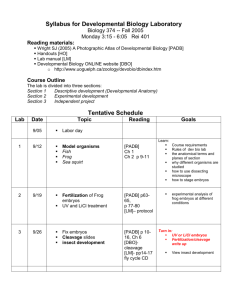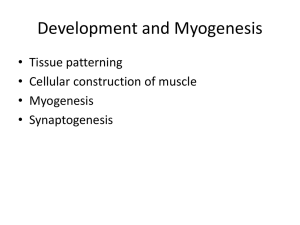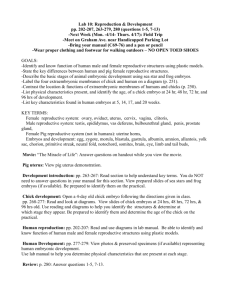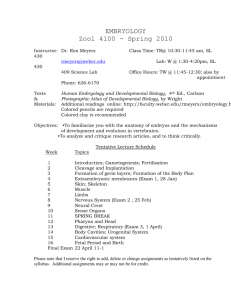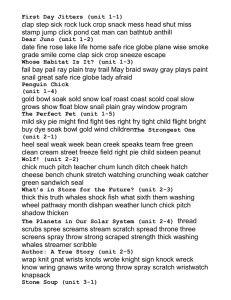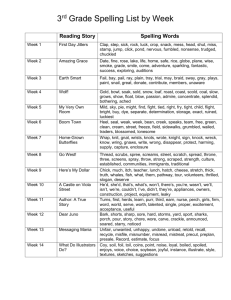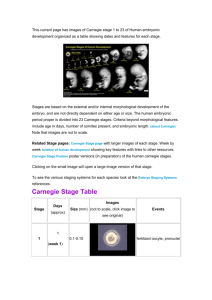The specificity of motor innervation of the chick wing does... upon the segmental origin of muscles
advertisement
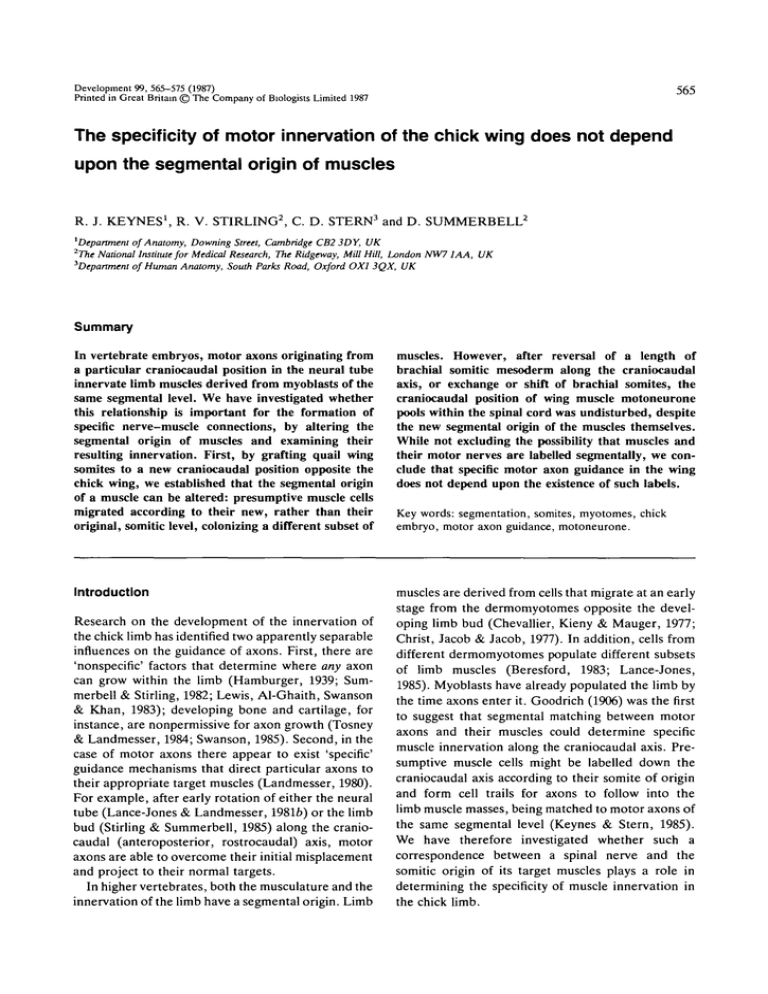
Development 99, 565-575 (1987) Printed in Great Britain © The Company of Biologists Limited 1987 565 The specificity of motor innervation of the chick wing does not depend upon the segmental origin of muscles R. J. KEYNES1, R. V. STIRLING2, C. D. STERN3 and D. SUMMERBELL2 1 Department of Anatomy, Downing Street, Cambridge CB2 3DY, UK The National Institute for Medical Research, The Ridgeway, Mill Hill, London NW71AA, ^Department of Human Anatomy, South Parks Road, Oxford OX1 3QX, UK 2 UK Summary In vertebrate embryos, motor axons originating from a particular craniocaudal position in the neural tube innervate limb muscles derived from myoblasts of the same segmental level. We have investigated whether this relationship is important for the formation of specific nerve-muscle connections, by altering the segmental origin of muscles and examining their resulting innervation. First, by grafting quail wing somites to a new craniocaudal position opposite the chick wing, we established that the segmental origin of a muscle can be altered: presumptive muscle cells migrated according to their new, rather than their original, somitic level, colonizing a different subset of muscles. However, after reversal of a length of brachial somitic mesoderm along the craniocaudal axis, or exchange or shift of brachial somites, the craniocaudal position of wing muscle motoneurone pools within the spinal cord was undisturbed, despite the new segmental origin of the muscles themselves. While not excluding the possibility that muscles and their motor nerves are labelled segmentally, we conclude that specific motor axon guidance in the wing does not depend upon the existence of such labels. Introduction muscles are derived from cells that migrate at an early stage from the dermomyotomes opposite the developing limb bud (Chevallier, Kieny & Mauger, 1977; Christ, Jacob & Jacob, 1977). In addition, cells from different dermomyotomes populate different subsets of limb muscles (Beresford, 1983; Lance-Jones, 1985). Myoblasts have already populated the limb by the time axons enter it. Goodrich (1906) was the first to suggest that segmental matching between motor axons and their muscles could determine specific muscle innervation along the craniocaudal axis. Presumptive muscle cells might be labelled down the craniocaudal axis according to their somite of origin and form cell trails for axons to follow into the limb muscle masses, being matched to motor axons of the same segmental level (Keynes & Stern, 1985). We have therefore investigated whether such a correspondence between a spinal nerve and the somitic origin of its target muscles plays a role in determining the specificity of muscle innervation in the chick limb. Research on the development of the innervation of the chick limb has identified two apparently separable influences on the guidance of axons. First, there are 'nonspecific' factors that determine where any axon can grow within the limb (Hamburger, 1939; Summerbell & Stirling, 1982; Lewis, Al-Ghaith, Swanson & Khan, 1983); developing bone and cartilage, for instance, are nonpermissive for axon growth (Tosney & Landmesser, 1984; Swanson, 1985). Second, in the case of motor axons there appear to exist 'specific' guidance mechanisms that direct particular axons to their appropriate target muscles (Landmesser, 1980). For example, after early rotation of either the neural tube (Lance-Jones & Landmesser, 19816) or the limb bud (Stirling & Summerbell, 1985) along the craniocaudal (anteroposterior, rostrocaudal) axis, motor axons are able to overcome their initial misplacement and project to their normal targets. In higher vertebrates, both the musculature and the innervation of the limb have a segmental origin. Limb Key words: segmentation, somites, myotomes, chick embryo, motor axon guidance, motoneurone. 566 R. J. Keynes, R. V. Stirling, C. D. Stern and D. Summerbell Materials and methods Embryo surgery Fertile hens' eggs (Light Sussex and Rhode Island Red, mixed flock) and quails' eggs were incubated at 38 °C for about 48 h to stages 11-13 (Hamburger & Hamilton, 1951). To construct quail/chick chimaeras, donor quail embryos were pinned out in Sylgard dishes containing 0-1 % trypsin (1:250, Difco) in calcium- and magnesium-free Tyrode's solution (CMF) at room temperature. Within a few minutes single somites could be removed for transplantation to a host chick embryo. In all cases the donor somite was still epithelial and had not developed into dermomyotome and sclerotome. After windowing the host eggs with a scalpel blade, the embryos were prepared by injecting a dilute solution (about 10 % in CMF) of India ink (Pelikan Fount India) into the sub-blastodermic space, and a somite was then removed opposite the presumptive wing bud region. As for the donor somites, the removed somite was still epithelial. In some cases the overlying ectoderm was simultaneously excised. Somite excision was greatly facilitated by placing a drop of the trypsin solution over the embryo, the enzyme being washed away with several changes of CMF before transferring the somite to be grafted. The graft was transferred with a siliconized glass pipette and then inserted into the cavity left behind by removal of the host somite. After adding three to four drops of a solution of Penicillin-G (50 units ml" 1 ), streptomycin sulphate (50/^gml"1) and Amphotericin-B (2-5 ^g ml" 1 ), the eggs were sealed with PVC tape and incubated to stages 33-35 before fixation and staining (see below). Craniocaudal reversal of a piece of segmental plate, four presumptive somites in length, was carried out in chick embryos. It was done either in ovo opposite one wing bud or as a donor-to-host operation using embryos of identical developmental stage and grafting to an identical craniocaudal level (Fig. 1). As specified in Table 1, in some cases only the dorsal half of the plate (which gives rise to the dermomyotome) was reversed, while in others the full thickness was reversed. Where only the dorsal half was reversed, the ventral half was removed before grafting. In some cases the mediolateral axis of the graft was also reversed, by confining the operation to one side of the embryo, while in others this axis was preserved, by grafting from one side of a donor embryo to the opposite side of the host. In previous experiments involving reversal of the segmental plate (Keynes & Stern, 1984), we found that to produce, say, four reversed somites simply required reversing a length of plate equivalent to the sum of four somites. In the present experiments the reversed piece came from the most cranial part of the segmental plate, corresponding to presumptive somites 17-20 or 18-21. The ectoderm overlying the reversed region was usually included in the reversal, but in three cases it was removed during the operation. After the operation, eggs were treated with antibiotics and sealed as described above and then incubated at 38 °C. For exchange or shift of somites, the grafting techniques were the same as described for chimaeras. For somite exchange, host chick embryos were incubated to the 20somite stage; somites 16 and 20 were removed from donor chick embryos of the same stage, and grafted so that somite 20 replaced host somite 16, and somite 16 replaced somite 20 (Fig. 1). For somite shift, donor somite 20 replaced host somite 16 (Fig. 1). Somites were counted from immediately caudal to the otic vesicle. Processing of chimaeric embryos Embryos were fixed in Zenker'sfixativefor 3-12 h, washed several hours in running tap water, dehydrated and cleared, embedded in paraffin wax, and sectioned transversely at 8-12 fxm on a rotary microtome. Sections were then stained either by Feulgen's method or with Harris's haematoxylin after acid hydrolysis (Hutson & Donahoe, 1984), to identify the position of the quail cells, made distinguishable by their prominent nucleolar staining (Le Douarin, 1973). Table 1. Retrograde HRP labelling Muscle injected Number operated Survivors Number with satisfactory labelling Reversal of both craniocaudal and mediolateral axes of segmental plate (full thickness) 12 4 3 Reversal of both craniocaudal and mediolateral axes of segmental plate (dorsal half only) 10 Operation Biceps Triceps (or EMR)* Result (pool position) 1 2 Normal Normal Reversal of craniocaudal axis of segmental plate (full thickness) 1 Exchange, somite 16 with 20 2 1 Normal Shift, somite 20 to 16 1 2 (*EMR) Normal *EMR - Extensor metacarpi radialis. Normal Segmentation and wing innervation in the chick Horseradish peroxidase (HRP) labelling (1) Retrograde labelling At 9-10 days of incubation (stages 33-35) the embryos were eviscerated, the brachial region removed and the spinal cord exposed (Summerbell & Stirling, 1981). After removing the overlying skin, muscle injections of HRP were made using a fine pipette to which air pressure was applied by mouth. The specimens were then incubated in oxygenated Tyrode's solution for 1 h at 37 °C, followed by 4h at room temperature, to minimize degenerative changes in the tissue during axonal transport of HRP. (2) Orthograde labelling At 8 days of incubation (stages 27-28) embryos were eviscerated and the brachial region pinned out in a Sylgard dish containing oxygenated Tyrode's solution at room temperature. The ventral spinal cord was exposed and 20-40 % w/v HRP (Boehringer grade 1) with 1 % aqueous Nonidet P40 (nonionic detergent, BDH) was injected bilaterally into the lateral ventral cord, opposite spinal nerve 16, with a fine glass microelectrode. Embryos were then incubated as described above. It should be noted that the numbering system of wing spinal nerves does not match that of the somites, because the four occipital somites do not carry spinal nerves. Thus spinal nerve 16 matches somite 20 (see, for example, Hunter, 1935). (3) HRP histochemistry At the end of the incubation period the specimens were pinned out, with limbs extended laterally, in Sylgard dishes containing cold 2% glutaraldehyde in 0 1 M-phosphate buffer at pH7-3. After 2h fixation the cords were washed repeatedly in phosphate buffer containing 20% sucrose, embedded in gelatin-albumen, and sectioned transversely at 60fun on a freezing microtome. The sections were collected in phosphate buffer, mounted on subbed slides, air dried and stained using the cobalt-nickel-enhanced DAB reaction (Adams, 1981). They were then counterstained with neutral red and mounted using DPX (Gurr). The wings were fixed overnight in 1 % glutaraldehyde, washed under running tap water and then stained as whole mounts with DAB (Landmesser, 1978). We found that sections could be cut more easily when the tissue had been dehydrated through butanol prior to wax embedding. Transverse sections were cut at 10 /zm and counterstained with cresyl violet. Limbs were reconstructed serially from camera-lucida drawings of each tenth section, using a digitizing tablet. Results Chick-quail chimaeras By transplanting single quail somites into chick embryos, Beresford (1983) has shown that specific Otic vesicle — S16 Segmental plate reversal 567 Exchange Fig. 1. Diagram illustrating the operations performed. To the left is a 16-somite embryo, showing the position of segmental plate reversal. To the right is a 20-somite embryo, showing how somites were grafted in the 'shift' and 'exchange' operations. 568 R. J. Keynes, R. V. Stirling, C. D. Stern and D. Summerbell muscles in the chick wing are colonized from specific somites. For example, when counting somites from immediately caudal to the otic vesicle, she finds that biceps muscle cells originate from somites 16-19 inclusive, while triceps cells originate from somites 18-21. In one graft of a quail 16th somite (ql6) to the 16th somite position in a chick host (cl6), we confirmed that the biceps, but not the triceps, is colonized from this somitic level. Similarly, the anterior (cranial) forearm muscle extensor metacarpi radialis (EMR) is colonized from this level, but not the posterior extensor metacarpi ulnaris (EMU). We also grafted quail somite 19 or 20 into position cl6, to see whether the quail cells migrate back to colonize muscles (such as the triceps and EMR) according to their original somitic level, or whether, alternatively, they contribute only to muscles characteristic of their new, grafted level. In all five such cases (two ql9 to cl6; two q20 to cl6; and one exchange graft comprising q20 to cl6 and cl6 to c20), quail cells were found in biceps but not in triceps (Fig. 2). Again, in three of these embryos (two q20 to cl6; one ql9 to cl6) the EMR was colonized, but the EMU was not (quail cells were not detected in the forearm in the two remaining grafts). In other words, cells migrated according to their new position in the host embryos and showed no tendency to alter their migration pathways in order to colonize muscles characteristic of their original level. Segmental plate reversal Chick embryos were used as both donors and hosts (see methods) and the segmental plate at presumptive somite positions 17-20 or 18-21 was reversed in all cases. The effect of the reversal was to shift a muscle's segmental origin by one or two segments along the craniocaudal axis of the embryo. Of 40 operated embryos, only 17 survived to stages suitable for HRP injection, with a high mortality between stages 30 and 33, when the ventral chest wall sometimes failed to close. In the survivors, apart from an occasional minor abnormality in the appearance of the shoulder girdle on the operated side, we could see no morphological differences between operated and control sides. Table 1 summarizes the types of operation and the resulting innervation pattern revealed by retrograde HRP labelling. 2A • B y* » *... - Fig. 2. (A) Section through the wing at midhumerus level in a stage-33 chick embryo in which a quail somite 20 replaced somite 16. Dorsal is uppermost, anterior (cranial) to the right; bar, 500//m. (B) High power of triceps muscle (left rectangle in A), containing only chick (host) cells. (C) High power of biceps muscle (right rectangle in A), containing a high proportion of quail cells with the nucleolar marker. (B,C) Bar, 50 jim. Segmentation and wing innervation in the chick ' V, N .• oN * 3A r v. 569 i ,' • ^» • . . / h I > • • m **: • ^ # ( / ) ^_ V , ^ F. - Fig. 3. The motor horns on unoperated (A,B,C) a nd operated (D,E,F) sides of a stage-30 embryo at the level of the 14th (A,D), 15th (B,E) and 16th (C,F) spinal nerves, following injection of HRP into the triceps muscle bilaterally. In this embryo, only the craniocaudal axis of the segmental plate had been reversed. The pattern of labelling is symmetrical with respect to the craniocaudal and mediolateral axes of the neural tube. The dashed lines enclose the motor horns. Bar, 100fsm. There were ten survivors in which both spinal cord and limb anatomies were satisfactory, and whose axons had incorporated and transported the HRP successfully. All had well-localized motor pools occupying the same position on the operated and unoperated sides (Fig. 3). The trajectories of axons filled from the injected muscle, and the overall nerve pattern, were also the same on the two sides (Fig. 4). This result was obtained whether or not the ectoderm overlying the segmental plate had been included in the reversal. There were three survivors with satisfactory orthograde HRP labelling. In each case, both craniocaudal and mediolateral axes of the segmental plate had been reversed. In one, the graft consisted of the full thickness of the segmental plate; in the others, only 570 R. J. Keynes, R. V. Stirling, C. D. Stern and D. Summerbell the dorsal half of the plate had been reversed. Each showed a symmetrical normal pattern of labelled axons after bilateral injection of HRP into the spinal cord at the level of spinal nerve 16. Fig. 5 shows the axons labelled on operated (half-thickness graft) and control sides, just proximal to the brachial plexus and further distal where the radial nerve moves dorsally around the humerus. Labelled axons maintain their caudal position through the plexus and distally they are found in the triceps and posterior wrist extensor muscles, but not in the anterior biceps nerve. Exchange or shift of somites In nine host embryos, somite 20 was replaced by somite 16 from a donor, and somite 16 by somite 20 (exchange). In eight host embryos, somite 16 was replaced by somite 20 from a donor (shift). As in the segmental plate reversals, the positions of the motor pools were identical to controls (Table 1). Fig. 6 15 shows the symmetrical appearance of the motor pools of biceps on operated and unoperated sides following somite replacement. Fig. 7 shows the symmetrical positions of EMR axons in the brachial plexus on the two sides, after the same operation. Discussion Each muscle in the limb is innervated by a cluster of motoneurones (the motor pool) situated at a characteristic position in the motor horn (Landmesser, 1978). Each motor pool extends along the craniocaudal axis of the neural tube, so that its axons usually project to the muscle in more than one spinal nerve. At the base of the limb the spinal nerves combine to form a plexus, within which axons destined for a particular muscle are found grouped together. After early reversal of either the neural tube (Lance-Jones & Landmesser, 1981b) or the limb bud (Stirling & 14 15 14 O Fig. 4. Serial transverse sections of unoperated (A) and operated (B) wings, reconstructed using a graphics tablet, showing the position of HRP-filled axons after triceps injection of the embryo illustrated in Fig. 3. The axonal branching pattern and the position of filled axons are similar on the two sides. The axes of the wings are the same, i.e. dorsal uppermost, cranial to the right. Segmentation and wing innervation in the chick Summerbell, 1985) about the craniocaudal axis, motor axons are able to overcome their initial misplacement and project to their appropriate muscles. This suggests that motor axons can respond to guidance cues along this axis. Since presumptive muscle cells migrate from the dermomyotomes to colonize specific limb muscles, the possibility arises that these cells form trails which axons might follow (Keynes & Stern, 1985). Such trails could be similar to the 'hypoglossal cord' of muscle cells in the occipital region of the embryo, which precedes the outgrowth of hypoglossal motor axons and is also somite-derived (Hunter, 1935; Hazleton, 1970). In the limb, however, the muscle cells stop emigrating well before axons reach its base; in the chick hindlimb, for example, muscle cells stop leaving the dermomyotomes at about stage 20 (Jacob, Christ & Jacob, 1979), while axons arrive at the base of the limb at about stage 23, almost 24 h later (Lance-Jones & Landmesser, 1981a). Preliminary studies with monoclonal antibodies that bind to migrating myoblasts nevertheless confirm 571 that muscle cell trails are still present at this stage (M. Solursh, personal communication). An attractive possibility is that presumptive muscle cells are labelled on a craniocaudal basis according to their somite of origin, and caiTy this label into the limb. Motor axons from the same segmental level might then associate with these cells in preference to those of any other level. Essentially the same idea was expressed by Goodrich (1906), who wrote 'that in a series of metameric myotomes and nerves each motor nerve remains faithful to its myotome, throughout the vicissitudes of phylogenetic and ontogenetic modification, may surely be considered as established The motor plexus of a limb is brought about, not by the nerve deserting one muscle for the sake of another, but by the combination of muscles derived from neighbouring segments.' We have shown, however, that if the segmental origin of a wing muscle is displaced along the craniocaudal axis by one or two segments, the muscle's motor innervation is not shifted in parallel; attractive as it may be, the .*' r^' _i • - *' • *- -# • Fig. 5. The distribution of axons filled from a bilateral injection of HRP into the ventral spinal cord, at the level of spinal nerve 16 in a stage-29 embryo, on unoperated (A,B) and operated (C,D) sides. The dorsal half of the segmental plate, together with overlying ectoderm, had been reversed in situ about both craniocaudal and mediolateral axes. In A and C the three spinal nerves have united before dividing into dorsal and ventral branches. In B and D, which are further distal, this division is now marked. The patterns of labelled and unlabelled axons are similar on the two sides. Dashed lines show the nerve boundaries; bar, 100/zm. 572 R. J. Keynes, R. V. Stirling, C. D. Stern and D. Summerbell simple hypothesis of strict segmental matching between nerve and muscle must be abandoned. This conclusion does, however, need a certain amount of justification. It is possible, for example, that after segmental plate reversal the premuscle cells are themselves guided back to their correct muscles. The results of grafting single quail somites into chick embryos show that this is not the case - with the proviso that quail cells respond normally in a chick environment. Since the dermomyotome forms from an inductive interaction between the epithelial somite t * and its overlying ectoderm (Gallera, 1966), it is also possible that the primary segmental information resides in the ectoderm (Child, 1921), and that the dermomyotomes become relabelled after segmental plate reversal. However, since limb innervation after segmental plate reversal was normal whether or not the ectoderm was included in the graft, we assume this is not the case. A final possibility is that translocated segmental plate or somitic mesoderm can be respecified according to its new position. Since both the dermatome (Mauger, 1972) and sclerotome — _ \ - ' v N • -•.- - v *• B **?*«;•• $ ^ I 9 W N Fig. 6. The motor horns on unoperated (A,B,C) and operated (D,E,F) sides of a stage-34 embryo, at the level of the 14th (A,D), 15th (B,E) and 16th (C,F) spinal nerves, following bilateral injection of the biceps muscle with HRP. On the operated side host somite 16 had been replaced by a donor somite 20. The labelled motoneurones occupy similar positions on the two sides. Dashed lines enclose the motor horns; bar, 100 jam. Segmentation and wing innervation in the chick >A 573 x »v Fig. 7. Sections at the brachial plexus, showing the similarity in position of axons (arrowed)filledby HRP injection of the EMR muscle on unoperated (A) and operated (B) sides. Axons in the plexus are just distal to the confluence of the 14th and 15th spinal nerves, and proximal to the point at which the 16th root joins. On the operated side the 16th somite had been replaced by a donor somite 20. Dashed lines show the nerve boundaries; bar, 100/im. (Kieny, Mauger & Sengel, 1972) are regionally determined along the craniocaudal axis prior to somite formation, we might reasonably expect that the same is true for putative axonal labels in the myotome and respecification does not occur. Preliminary analysis of the motor innervation of duplicated chick wings, where a second (mirrorimage) wing is induced by grafting material from the zone of polarizing activity, confirms the present results (Stirling & Summerbell, unpublished observations). Axons from caudal lateral motor cells, which normally innervate forearm extensors lying caudally in the wing, innervate the duplicate caudal forearm extensors despite the muscles' cranial position in the duplicated wing and their probable origin from more cranial somites. Lewis, Chevallier, Kieny & Wolpert (1981) have shown that the gross branching pattern of nerves is normal in wings made muscleless by somite ablation. Furthermore, recent experiments (Phelan & Hollyday, 1986) on the distribution of motor axons in muscleless wings suggest that the presence of myoblasts is not essential for normal axon guidance. It therefore seems that we should look to cells derived from the lateral plate mesoderm, such as the connective tissue cells, for an explanation of specific axon guidance in the limb. If the process of axial segmentation does not play a role in guiding axons in the limb, it is clear that it does do so at an earlier stage, when axons traverse the sclerotome neighbouring the neural tube (Keynes & Stern, 1984). It may also be involved at the stage of target recognition, when motor axons innervate their muscles. For example, in the case of axial muscles, the experiments of Wigston & Sanes (1982) suggest that the segmentally derived intercostal muscles retain some label, perhaps segmentally determined, which biases the innervation they receive. In the embryonic zebrafish the primary motoneurones are segment restricted as they innervate the myotomes (Eisen, Myers & Westerfield, 1986), a phenomenon which could also be explained on the basis of segmental labelling. In the limb, target segmental matching may be retained within muscles, so that motor axons synapse preferentially with muscle fibres derived from the same craniocaudal level. Consistent with this, in the chick there is a correlation between the craniocaudal level of origin of hindlimb motoneurones and that of the muscle cells they innervate (Lance-Jones, 1985). Connections that are less well matched on the craniocaudal axis could be removed by cell death and/or synapse elimination (see Bennett & Lavidis, 1982, 1984; Brown & Booth, 1983). Presumably the limb, in evolving from the segmented fish fin, required that the segment boundaries be fused or transcended, in order to make plurisegmental muscles and apparently nonsegmented structures such as the constituent bones. During this process, novel and additional mechanisms may have arisen to guide axons to their targets. 574 R. J. Keynes, R. V. Stirling, C. D. Stern and D. Summerbell References JACOB, M., CHRIST, B. & JACOB, H. J. (1979). The J. C. (1981). Heavy metal intensification of DAB-based HRP reaction product. J. Histochem. Cytochem. 29, 775. BENNETT, M. R. & LAVTDIS, N. A. (1982). Development of the topographic projection of motoneurones to amphibian muscle accompanies motor neuron death. Dev. Brain Res. 2, 448-452. BENNETT, M. R. & LAVTDIS, N. A. (1984). Development of the topographical projection of motoneurones to a rat muscle accompanies loss of polyneuronal innervation. /. Neurosci. 4, 2204-2212. BERESFORD, B. (1983). Brachial muscles in the chick embryo: the fate of individual somites. /. Embryol. exp. Morph. 77, 99-116. migration of myogenic cells from the somites into the leg region of avian embryos. An ultrastructural study. Anat. Embryol. 157, 291-309. KEYNES, R. J. & STERN, C. D. (1984). Segmentation in the vertebrate nervous system. Nature, Lond. 310, 786-789. KEYNES, R. J. & STERN, C. D. (1985). Segmentation and neural development in vertebrates. Trends Neurosci. 8, 220-223. KIENY, M., MAUGER, A. & SENGEL, P. (1972). Early regionalisation of the somitic mesoderm as studied by the development of the axial skeleton of the chick embryo. Devi Biol. 28, 142-161. LANCE-JONES, C. (1985). The somitic origin of limb muscles in the chick embryo: a correlation with motor innervation. Abstracts Soc. Neurosci. 11, 288.2. ADAMS, BROWN, M. C. & BOOTH, C. M. (1983). Postnatal development of the adult pattern of motor axon distribution in rat muscle. Nature, Lond. 304, 741—742. CHEVALLIER, A., KTENY, M. & MAUGER, A. (1977). Limb-somite relationships: origin of the limb musculature. J. Embryol. exp. Morph. 41, 245-258. CHILD, C. M. (1921). The Origin and Development of the Nervous System, p. 141. Illinois: Univ. Chicago Press, CHRIST, B., JACOB, H. J. & JACOB, M. Experimental analysis of the origin of the wing musculature in avian embryos. Anat. Embryol. 150, 171-186. EISEN, J. S., MYERS, P. Z. & WESTERFIELD, M. (1986). Pathway selection by growth cones of identified motoneurones in live zebra fish embryos. Nature, Lond. 320, 269-271. FERGUSON, B. A. (1983). Development of motor innervation of the chick following dorsal—ventral limb bud rotations. J. Neurosci. 3, 1760-1772. GALLERA, J. (1966). Mise en evidence du r61e de l'ectoblaste dans la differentiation des somites chez les oiseaux. Rev. Suisse Zool. 73, 492-503. GOODRICH, E. S. (1906). On the development of the fins of fish. Q. Jl Microsc. Sci. 50, 333-376. HAMBURGER, V. (1939). The development and innervation of transplanted limb primordia of chick embryos. /. exp. Zool. 80, 347-390. HAMBURGER, V. & HAMILTON, H. L. (1951). A series of normal stages in the development of the chick embryo. /. Morph. 88, 49-92. HAZLETON, R. D. (1970). A radioautographic analysis of the migration and fate of cells derived from the occipital somites in the chick embryo with specific reference to the development of the hypoglossal musculature. J. Embryol. exp. Morph. 24, 455—466. HUNTER, R. P. (1935). The early development of the hypoglossal musculature in the chick. /. Morph. 57, 473-499. HUTSON, J. M. & DONAHOE, P. K. (1984). Improved histology for the chick-quail chimaera. Stain Technol. 59, 105-112. LANCE-JONES, C. & LANDMESSER, L. (1981a). Pathway selection by chick lumbosacral motoneurons during normal development. Proc. R. Soc. B 214, 1-18. LANCE-JONES, C. & LANDMESSER, L. (1981b). Pathway selection by embryonic chick motoneurons in an experimentally altered environment. Proc. R. Soc. B 214, 19-52. LANDMESSER, L. (1978). The distribution of motoneurones supplying chick hindlimb muscles. J. Physiol. 284, 371-389. LANDMESSER, L. (1980). The generation of neuromuscular specificity. A. Rev. Neurosci. 3, 279-302. LE DOUARIN, N. M. (1973). A Feulgen-positive nucleolus. Expl Cell Res. 77, 459-468. LEWIS, J., AL-GHATTH, L., SWANSON, G. & KHAN, A. (1983). The control of axon outgrowth in the developing chick wing. In Limb Development and Regeneration, part A (ed. J. F. Fallon & A. I. Caplan), pp. 195-205. New York: Alan R. Liss Inc. LEWIS, J., CHEVALLIER, A., KIENY, M. & WOLPERT, L. (1981). Muscle nerve branches do not develop in chick wings devoid of muscle. J. Embryol. exp. Morph. 64, 211-232. MAUGER, A. (1972). Role du m6sodenne somitique dans le deVeloppement du plumage dorsal chez l'embryon de poulet. II. R6gionalisation du m^soderme plumigene. J. Embryol. exp. Morph. 28, 343-366. PHELAN, K. & HOLLYDAY, M. (1986). Pathway selection in muscleless chick limbs. Abstracts Soc. Neurosci. 12, 331.6. STIRLING, R. V. & SUMMERBELL, D. (1985). The behaviour of growing axons invading developing chick wing buds with dorsoventral or anteroposterior axis reversed. J. Embryol. exp. Morph. 85, 251-269. SUMMERBELL, D. & STIRLING, R. V. (1981). The innervation of dorso-ventrally reversed chick wings: evidence that motor axons do not actively seek out their appropriate targets. J. Embryol. exp. Morph. 61, 233-247. Segmentation and wing innervation in the chick D. & STIRLING, R. V. (1982). Development of the pattern of innervation of the chick limb. Am. Zool. 22, 173-184. SWANSON, G. J. (1985). Paths taken by sensory nerve fibres in aneural wing buds. J. Embryol. exp. Morph. 86, 109-214. SUMMERBELL, 575 degrees of chick limb bud ablation. J. Neurosci. 4, 2518-2527. WIGSTON, D. J. & SANES, J. R. (1982). Selective reinnervation of adult mammalian muscle by axons from different segmental levels. Nature, Lond. 299, 464-467. TOSNEY, K. W. & LANDMESSER, L. T. (1984). Pattern and specificity of axonal outgrowth following varying (Accepted 17 December 1986)
